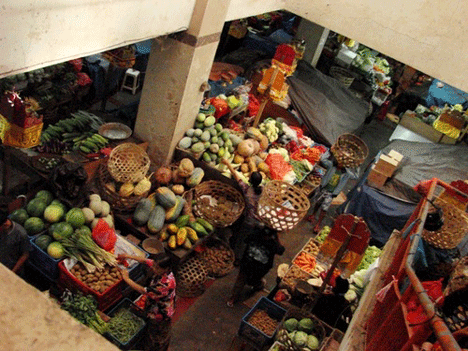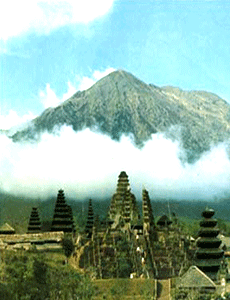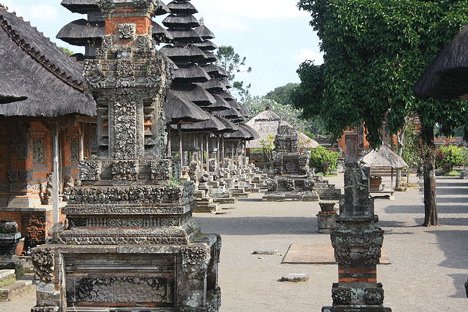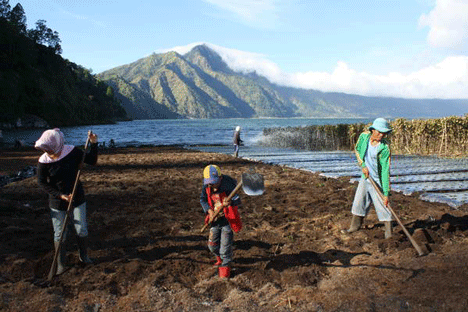Tanah Lot is claimed to be the work of the 15th century priest Nirartha. During his travels along the south coast he saw the rock-island's beautiful setting and rested there.
Some fishermen saw him, and bought him gifts. Nirartha then spent the night on the little island. Later he spoke to the fishermen and told them to build a shrine on the rock for he felt it to be a holy place to worship the Balinese sea gods.
BALI ANJANI VACATIONS provides accommodations, hotels, villas, Tour Packages and General Informations for your lovely holiday in Bali and Beyond
The Tanah Lot temple was built and has been a part of Balinese mythology for centuries. The temple is one of seven sea temples around the Balinese coast. Each of the sea temples were established within eyesight of the next to form a chain along the south-western coast.
At the base of the rocky island, poisonous sea snakes are believed to guard the temple from evil spirits and intruders. A giant snake purportedly protects the temple, which was created from Niratha’s scarf when he established the island.
In 1980 the temple’s rock face was starting to crumble and the area around and inside the temple started to become dangerous. The Japanese government then provided a loan to the Indonesia government of Rp 800 billion (approximately USD $130 million) to conserve the historic temple and other significant locations around Bali. As a result, over one third of Tanah Lot's "rock" is actually cleverly disguised artificial rock created during the Japanese-funded and supervised renovation and stabilization program. (http://en.wikipedia.org/wiki/Tanah_Lot)
On Tanah Lot temple area you can also find some other temples ;
Penataran Temple
Penataran Temple is one among of several temples in Tanah Lot area. It is located in the north of Tanah Lot Temple. Penataran Temple is a place to pray for God and his manifestation in Tanah Lot Temple for wellness and happyness. The Ceremony of Penataran Temple has two ceremony days, the first day is same as Tanah Lot Temple which is held every 210 days on “Rebo Wage, Wara Langkir”, and the second day is on “Rebo Wage, Wara Merakih” according to the Balinese calendar.
Penyawang Temple
Penyawang Temple is located in the west side of Penataran Temple. This temple was built for all prayers to pray for God and the manifestation who take place and has authority in Tanah Lot Temple as God of the ocean. If the water of the sea was tide, Hindus people cannot pray into the Tanah Lot Temple but they can pray at Penyawang Temple.
Jero Kandang Temple
Jero Kandang Temple is located about 100 meters in the west side of Penyawang Temple. Jero Kandang Temple was built for villagers of Beraban village to require the wellness for their animals and plants from disease. The name of Jero Kandang Temple was took from the function that is put into a stable (kandang) all the disease. Based on the function, Jero Kandang Temple is a place to pray for God with the manifestation as the God of all animals and plants, also pray for Dewi Sri as manifestation of God as the Goddess of prosperity.The Ceremony of Jero Kandang Temple is every Sabtu (Saturday) Kliwon, Wara Uye or Tumpek Kandang day according to Balinese calendar.
Enjung Galuh Temple
Enjung Galuh Temple is located near Jero Kandang Temple to be exact at Enjung Galuh, “njung” wich is rock stick out in to the sea. Enjung Galuh Temple was built to pray for the Goddess of prosperity Dewi Sri as the power (Shakti) of Dewa Wisnu (God Manifestation as The Protector). The villagers pray requiring the fertility of the plants and rice-plant for the achievement of the prosperity in their life. The Ceremony of Enjung Galuh Temple is every Rabu (Wednesday) Umanis, Wara Medangsia according to Balinese calendar.
Batu Bolong Temple
Batu Bolong Temple is located 100 meters in the west side of Enjung Galuh Temple, to be exact at Enjung Batu Bolong, which is the rock that stick out in to the sea was hollow (bolong). Batu Bolong Temple was built to pray God for holiness. Enjung Batu Bolong area is a place that always used to held Melasti Ceremony and Pakelem Ceremony, where the meaning of both Ceremonies is to purify the world. The Ceremony of Batu Bolong Temple is every Rabu (Wednesday) Wage, Wara Langkir according to the Balinese calendar.
Batu Mejan Temple
Batu Mejan Temple is located 100 meters in the west side of Batu Bolong Temple. Batu Mejan Temple also known as Beji Temple, “beji” means holly place to get holly water for Hindus ceremonial. Batu Mejan Temple was built for villagers to beg a mercy from God trough holly water.In the south of Batu Mejan Temple along the beach, there was spring water and we could find it clearly when the sea water was decrease. Hindus people believe that spring water was holly water (tirtha pangelukatan) that could be use to purify all the badness.The Ceremony of Batu Mejan Temple is every Sabtu (Saturday) Kliwon, Wara Kuningan or Kuningan Day according to the Balinese calendar.
Pakendungan Temple
Pakendungan Temple is located in west side in Tanah Lot Area it is just 300 meters from Tanah Lot Temple. It was built in year Çaka 1330 to be exact in year 1408. Pakendungan Temple has one unity with Tanah Lot Temple. When Dang Hyang Nirartha continue his journey to find the Holy Light in Segara (Sea) Kidul Tanah Lot, he was do meditation (yoga semadi) in luxuriant forest in the west side of Segara (sea) Kidul Tanah Lot to get some vision of God about the Holy light. The forest name was known as Kendung Forest. The place that used by Dang Hyang Nirartha meditate, was built a temple and known as Pakendungan Temple. Pakendungan temple is place where Keris sakti (Holy Keris) “Ki Baru Gajah” that had power to subjugate all the disease plants in Bali Island was kept. Keris Ki Baru Gajah was holy keris given by Dang Hyang Nirartha to the Chief of Beraban Village before He leave the Beraban village. This ancient Ki Baru Gajah was kept in Puri Kediri and its Ceremonial is same with Pakendungan Temple Ceremonial is every 210 days in Sabtu (Saturday) Kliwon, Wara Kuningan or Kuningan Day, according Balinese calendar.
Tri Antaka Monument
Since March 1946, the NICA (Netherlands Indies Civil Administration) had already full power in Tabanan Town. There is a man “I Gusti Ketut Kereg” and his friend “I Wayan Kamias” at that time was given an assignment to be a spy for the Main Army Station of Republic of Indonesia Fights Council under leader of Letkol I Gusti Ngurah Rai to fight against the NICA army. All the Indonesian freedom fighter of Tabanan including I Gusti Ketut Kereg and his friend started to search safe place in some villages in the South of Tabanan and keep fighting. Until June 10th 1946 they was hemmed in Tanah Lot Area and started to fire at each other with NICA army, so that I Gusti Ketut Kereg and his friend was killed and NICA army also had successful prisoner 90 the other Indonesian fighters and killed one of them “I Nyoman Regug” from Beraban village. To respect all the merit of their fighting against the NICA for Indonesian freedom, the Local Government with Beraban Villagers built the Monument at that place where I Gusti Ketut Kereg, I Wayan Kamias and I Nyoman Regug was killed.The Monument name is TRI ANTAKA.
More Info :
Source:
http://balianjanivacation.blogspot.com/2011/08/tanah-lot-sunset-temple.html





















